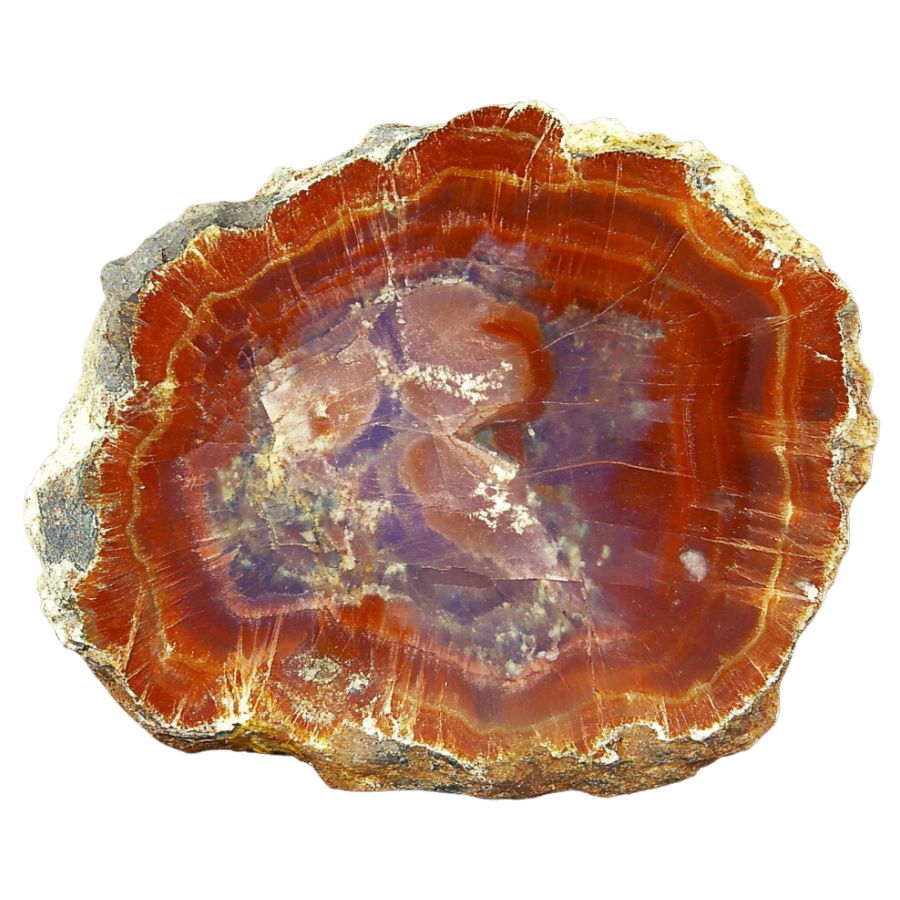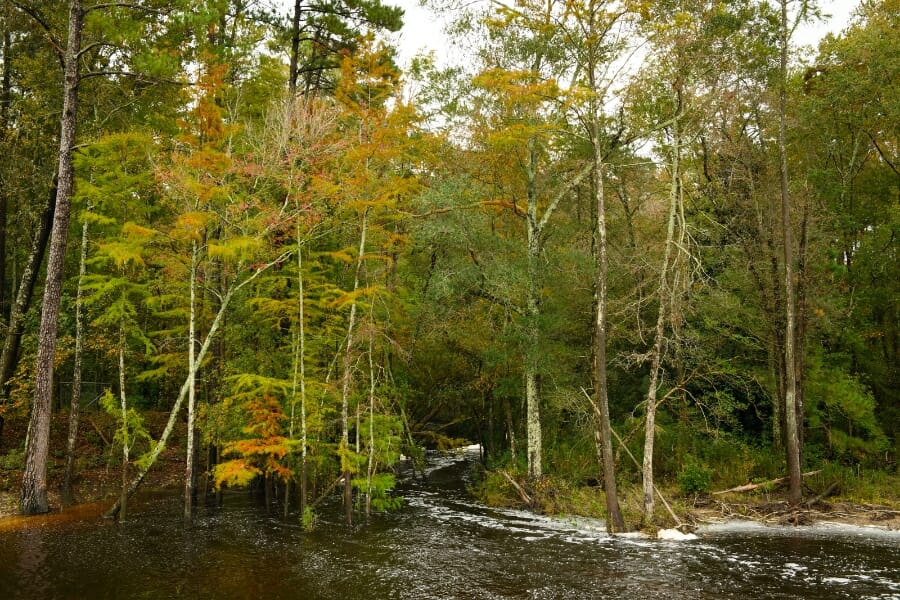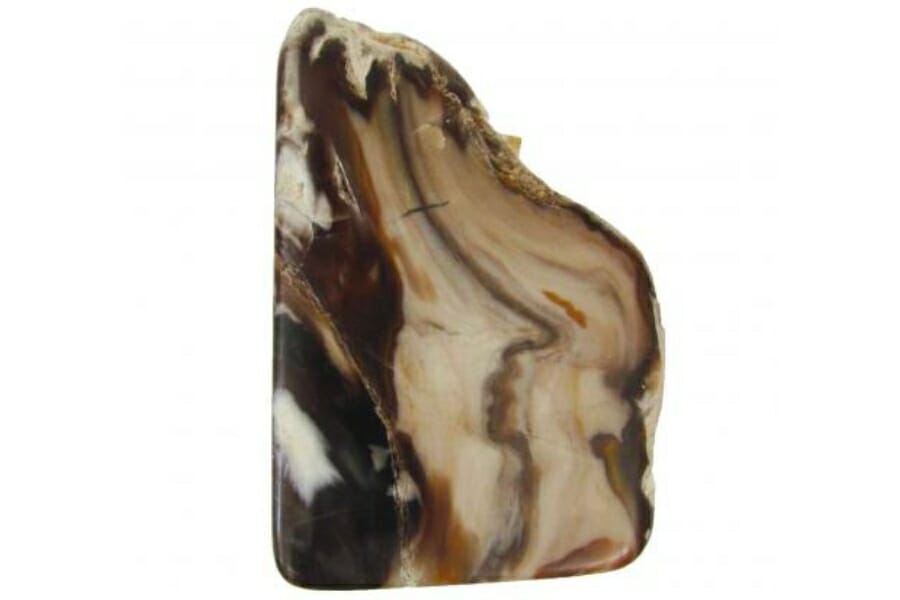Exploring the state’s rugged terrain offers a unique opportunity to discover petrified wood, a fossilized treasure from ancient forests. With the right tips, you’ll be ready to embark on your own adventure and uncover these fascinating remnants of prehistoric life.
Knowing where to look and what to expect will increase your chances of spotting these remarkable pieces scattered across this great state’s terrain!
Petrified wood you can find in the US
In the United States, several types of petrified wood can be found, each with unique characteristics based on the original tree species and the minerals involved in the fossilization process. Here are some of the types you’ll be able to find.
Araucarioxylon

Found in the Petrified Forest National Park in Arizona, this is one of the most famous types of petrified wood. It comes from an extinct species of conifer. As Arizona’s state fossil, Araucarioxylon holds a special place in the state’s natural history.
These trees once formed vast forests during the Late Triassic period, about 225 million years ago. The vibrant colors in this petrified wood come from minerals that replaced the original tree material over time.
Metasequoia

Often referred to as dawn redwood, this type of petrified wood can be found in various parts of the U.S., including the Pacific Northwest. Metasequoia was once thought to be extinct until living trees were later discovered in China.
Furthermore, its fine grain and reddish-brown color are characteristic features.
Palmoxylon

This petrified wood originates from palm trees and is often found in the Gulf Coast states like Texas and Louisiana. Recognized as the state stone of Texas, Palmoxylon is abundant and holds cultural significance.
The wood’s unique speckled or dotted pattern comes from the vascular bundles of the original palm tree. These fossils date back to the Cretaceous period, when the area was tropical and teeming with life.
Taxodium

Also known as bald cypress, this petrified wood can be found in the southeastern U.S., particularly in areas that were once swampy. Taxodium wood is often found in places that were ancient swamps, where these trees thrived millions of years ago.
The wood is durable and shows intricate grain patterns, with growth rings and knotholes that tell the story of its long history. It’s a fascinating glimpse into the wet environments that once dominated the Southeast.
Sequoioxylon

Petrified wood from ancient sequoia trees, found in places like California, where sequoia forests once thrived. These trees are the ancestors of the giant sequoias that still stand in California today.
The petrified wood is notable for its large, straight grain and reddish color, reflecting the immense size and age of the original trees.
Ginkgoxylon

Petrified wood from ancient ginkgo trees, which can sometimes be found in states like Oregon and Washington. Ginkgo is one of the oldest tree species on Earth, with fossils dating back over 200 million years.
Ginkgo petrified wood often has a light color and may show patterns similar to the fan-shaped leaves of the living ginkgo.
Dicotyledonous Wood

Found across various states, this type of petrified wood comes from broadleaf trees, making it more common and varied in appearance. You can spot dicotyledonous wood by the distinct vessels and growth rings that indicate seasonal changes.
This type of petrified wood is often found in regions that were once temperate forests, offering clues about the diverse plant life that existed millions of years ago.
Piceoxylon

Petrified wood from ancient spruce trees, commonly found in areas like Wyoming and Montana, where coniferous forests once thrived. Piceoxylon is known for its straight grain and pale color, often showing growth rings that tell the tree’s life story.
These trees were part of the ancient boreal forests that covered large parts of North America during cooler periods.
A Quick Request About Collecting
Always Confirm Access and Collection Rules!
Before heading out to any of the locations on our list you need to confirm access requirements and collection rules for both public and private locations directly with the location. We haven’t personally verified every location and the access requirements and collection rules often change without notice.
Many of the locations we mention will not allow collecting but are still great places for those who love to find beautiful rocks and minerals in the wild without keeping them. We also can’t guarantee you will find anything in these locations since they are constantly changing.
Always get updated information directly from the source ahead of time to ensure responsible rockhounding. If you want even more current options it’s always a good idea to contact local rock and mineral clubs and groups
What Rough Petrified Wood Looks Like
Most of the photos you find of petrified wood are pieces that have been cut and polished. That is certainly useful but isn’t super helpful once you are out in the field. This is what you should look out for once you start hunting:
Exteriors like this

Every type of petrified wood has a different exterior and pattern but this is a good starting point on what to look for.
Texture and grain patterns

One of the most distinctive features to look for is the texture and grain patterns. Petrified wood often retains the original structure of the tree, including the grain, knots, and even growth rings. These patterns can appear similar to modern wood but are typically more rigid and fossilized.
Examine the surface for any linear patterns or striations that indicate the original wood grain. The texture may feel smoother or more polished in certain areas where mineralization has created a glassy effect.
Coloration and mineralization

The color of petrified wood can vary significantly due to the minerals that replaced the organic material during the fossilization process. Common colors include shades of brown, red, yellow, orange, and black.
Some pieces might even exhibit multiple colors in intricate patterns. These colors are often more vivid and diverse than those found in regular rocks. When inspecting potential petrified wood, look for these distinct and varied hues, which can indicate the presence of different minerals such as silica, iron, manganese, and others that contributed to the petrification process.
Bark and exterior features

Another telltale sign of petrified wood is the presence of bark impressions or external textures that resemble tree bark. These features are often well-preserved and can include the rough, fibrous texture of bark, knots, or other surface irregularities typical of natural wood.
The exterior of rough petrified wood may also have a weathered appearance, with cracks and fractures that occurred as the wood fossilized over millions of years. Look closely for these natural wood features, as they can be a strong indicator that you have found a piece of petrified wood.
Weight and density

Petrified wood is typically much heavier and denser than regular wood due to the mineralization process. When rockhounding, pick up the specimen to feel its weight. Even small pieces of petrified wood will feel significantly heavier than an equivalent-sized piece of non-fossilized wood.
This increased density is due to the replacement of organic material with minerals, making petrified wood feel more like a rock than wood. Comparing the weight and density of your find with known samples of petrified wood can help confirm its authenticity.
- The extensive local experience of our team
- Input from a variety of local rockhounds and rockhound groups
- The difficulty in accessing a location
- Safety and potential hazards when collecting
- Private and public locations
- A desire to include locations for both the experienced and newbie hunters who are just starting out
Using these inputs we think we’ve put together the best list out there for those who love finding petrified wood for our collections!
General Areas To Try First

Before we get into the specific places you should be looking we wanted to give you some more general advice. Once you get to your hunting area you should head straight for these areas if you want to have the best results:
Lakeshores

Lakeshores are like natural garbage cans because all things wash up and get left there over time. That includes wood that has turned to stone. As the water rises and falls, it carries sediment and rocks. It also takes the fossilized remains of trees from long ago.
Most lakeshores have a variety of rocks and minerals, which makes them an excellent place for petrified wood to grow and thrive. You’ll find a nice mix of sedimentary and volcanic rocks, the best sites for preserving wood fossils.
Roadcuts

When building roads, parts of the ground are often cut away to make a smooth path. The magic happens when the road cuts through layers of rock and soil. Petrified wood is often buried deep underground, and roadcuts let us see these underground wonders.
As workers blast through the rock layers, they accidentally find petrified wood that has been there for hundreds of years. Petrified wood is easy for collectors to spot because the exposed rock layers of roadcuts make it easy to see its unique patterns and colors.
Streams and creeks

Streams and creeks can move loose sediment away, which can reveal old wood that has turned to stone. As the water moves around, it exposes small pieces or even more significant amounts of petrified wood that have settled on the streambed.
Streams and creeks are more accessible for collectors because they are not as big. You can easily walk along their banks, jump from rock to rock, and look for petrified wood at the water’s edge.
River beds

Riverbeds are excellent for finding petrified wood due to their unique geological and environmental conditions. Rapid burial by sediments like sand, silt, and mud protects fallen trees from decay, initiating the fossilization process.
Mineral-rich waters flowing through rivers facilitate the replacement of organic material with minerals such as silica, turning wood into stone. Over time, erosion exposes these buried treasures, making them accessible for discovery.
This dynamic environment, with constant sediment deposition and mineral infiltration, creates ideal conditions for the formation and eventual exposure of petrified wood.
DON'T MISS OUT ON ANY GREAT FINDS!
While you're out searching for Petrified Wood you're going to find A LOT of other interesting rocks and minerals along the way. The last thing you want to do is toss out something really interesting or valuable. It can be easy to misidentify things without a little guidance.
We've put together a fantastic field guide that makes identifying 140 of the most interesting and valuable rocks and minerals you will find REALLY EASY. It's simple to use, really durable, and will allow you to identify just about any rock and mineral you come across. Make sure you bring it along on your hunt!
The Best Places To Find Petrified Wood In North Carolina
Endowed with an amazing array of natural treasures, North Carolina has many great rockhounding sites. But if you want to focus your search on petrified wood, you should be aware that not all of these sites have them.
Here are our recommended legit places that you can explore:
Always Confirm Access and Collection Rules!
Before heading out to any of the locations on our list you need to confirm access requirements and collection rules for both public and private locations directly with the location. We haven’t personally verified every location and the access requirements and collection rules often change without notice.
Many of the locations we mention will not allow collecting but are still great places for those who love to find beautiful rocks and minerals in the wild without keeping them. We also can’t guarantee you will find anything in these locations since they are constantly changing.
Always get updated information directly from the source ahead of time to ensure responsible rockhounding. If you want even more current options it’s always a good idea to contact local rock and mineral clubs and groups
Pee Dee River

Pee Dee River stretches a long way, starting from the Appalachian Mountains and winding its way down to the coastal plains. Along its journey, it travels through a variety of landscapes, each more beautiful than the last.
It’s mainly found in the southern part of our state, making its way toward South Carolina. It’s surrounded by lush green forests, gentle rolling hills, and sandy banks.
The river has carved its way through layers of rock, some of which are super old. As it flows, it exposes different types of rocks and minerals. You can find petrified wood, shiny minerals, or even gemstones here.
If you want to pay a visit here, it’s pretty easy to get to. Major roads and highways lead to various access points along the river. But before you head out, make sure to review our local collecting guidelines at the North Carolina Department of Environmental Quality (DEQ) website.
Where we found petrified wood in Pee Dee River
You can find agatized wood if you explore the gravels of the Pee Dee River and its tributaries.
Beaverdam Creek

Flowing through the scenic landscapes of the Tar Heel State, Beaverdam Creek offers a glimpse into the beautiful world of nature and geology.
It weaves its way through parts of our state, surrounded by woodlands and open fields. The areas around it are just as diverse, if not more. In some spots, it’s surrounded by dense forests. In other areas, it stretches across open fields.
If you’re wondering about its accessibility, Beaverdam Creek is quite visitor-friendly. The roads leading to it are well-marked, and there are several spots where you can park and start your adventure.
Where we found petrified wood in Beaverdam Creek
We recommend searching through the gravels of Beaverdam Creek to find fascinating samples of petrified wood.
Cumberland County

Cumberland County is a spot where geography, terrain, and geology all come together to paint a fascinating picture.
It’s comfortably positioned in our state’s Sandhills region. This means it’s not too far from the coast, but it’s also got some unique features that set it apart from its neighboring counties.
Geologically speaking, Cumberland County is a treat for rockhounds. While the sandy terrain tells tales of ancient seas, the area is also rich in minerals. It’s not uncommon to find different natural wonders here, including petrified wood.
Another great thing about this place is that with major highways running through it, including Interstate 95, it’s easily accessible wherever you’re coming from. Once you’re here, a network of local roads makes it simple to explore it.
Where we found petrified wood in the Cumberland County
You can collect agatized wood countywide in Cumberland, particularly in stream gravels and alluvial deposits, gravel pits, excavations, and road cuts.
Cape Fear River

Stretching over 200 miles, Cape Fear River runs from the center of our state all the way to the Atlantic Ocean. It’s one of the longest rivers here and has played a big part in our history and growth.
The river starts in the Piedmont region, where smaller streams come together. Along its path going to the Atlantic, the Cape Fear River passes through varied landscapes— from dense forests to sprawling wetlands.
The terrain around this river is diverse. Upstream, you might encounter rolling hills and valleys, while downstream, it widens and is bordered by marshes and swamps. The river’s banks and bed are also prime spots to find rocks and minerals.
To get here, look for major roads and highways that crisscross the river’s length (it wouldn’t be hard to find because it has plenty of access points).
Where we found petrified wood in Cape Fear River
If you want to find agatized wood, make sure you explore the gravel beds of Cape Fear River and its tributaries.
Eno River

Eno River spans around 33 miles, which is smaller than some. Despite this, it’s packed with wonders and stories.
This river springs to life in Orange County and flows eastward. As it moves, it dances through Durham County before eventually joining the bigger Neuse River.
Around the river, you’ll see gentle hills, thick woods, and even some rocky outcrops. Eno River itself sometimes flows calmly and at other times rushes over rapids, which is very interesting!
Wondering how to get here? It’s a piece of cake! Eno River is well-connected with roads, and there’s even the Eno River State Park which offers easy access. It has trails, camping areas, and informational signs to guide and teach visitors.
Where we found petrified wood in Eno River
To find agatized wood, you can search through the gravels of Eno River.
Other Great Places To Find North Carolina Petrified Wood

Aside from our top recommendations, there are a few other North Carolina petrified wood-bearing sites that you can consider visiting, such as:
| County | Location |
| Durham | Area fields, cuts, and gravels of Bethesda |
| Durham | Near junction of US 75 and Route 98 in Durham |
| Halifax | All exposures of Quaternary gravels throughout the county |
| Montgomery | Area stream gravels of Troy |
| Orange | Area woods, fields, creek gravels of Chapel Hill |
| Richmond | Area streambeds of Ellberle |
Common Questions About Finding Petrified Wood In North Carolina

To help you ensure a successful petrified wood hunting experience, we’ll answer some of the most common questions when it comes to finding petrified wood in North Carolina:
How old is Petrified Wood in North Carolina
Most of the petrified wood from North Carolina dates back to the Triassic and Jurassic periods, making it between 230 and 190 million years old!
During these eras, our state had a vastly different landscape filled with expansive forests. As trees fell and were swiftly covered by sediments from nearby rivers, lakes, or even volcanic activity, the conditions were just right for petrification.
Can you find Petrified Palm Wood in North Carolina?
While we have petrified wood in our state, petrified palm is not commonly found here. Our past environments and conditions were more conducive to other types of vegetation rather than palm trees.
If you’re on the hunt specifically for petrified palm, regions with a known history of ancient tropical or subtropical climates might be more promising.
The Best Places To Buy Petrified Wood In North Carolina

Another great way to observe, get your hands on and take home North Carolina petrified wood is by visiting our trusted local shops that sell them. We’ve listed down some of our most recommended stores below:
- Cornerstone Minerals LLC – 52 N Lexington Ave, Asheville, NC 28801
- Enter the Earth – 1 Page Ave #125, Asheville, NC 28801
- Mineralogy – 6910 Fayetteville Rd #109, Durham, NC 27713
- Rocks and Things – 114 Oak Ave, Spruce Pine, NC 28777
- The Fossil Exchange – 7110 Wrightsville Ave Ste B6, Wilmington, NC 28403


